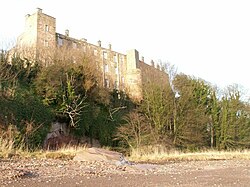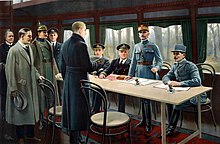Rosslyn Wemyss, 1st Baron Wester Wemyss
Navy Distinguished Service Medal (United States) |
|---|

Born the youngest son of James Hay Erskine Wemyss and Millicent Ann Mary Kennedy Wemyss (née Erskine), Wemyss (pronounced "Weems") he was raised at the ancestral home of Wemyss Castle on the Fife coast.[1]
He joined the
Wemyss joined the Royal Yacht
Given command of the cruiser
First World War and after

Wemyss served in the
Wemyss became Commander of the
Returning to the Admiralty, Wemyss was appointed

Wemyss was the senior British representative at the signing of the
Wemyss was promoted to Admiral of the Fleet on 1 November 1919. In retirement he wrote his memoirs under the title The Navy in the Dardanelles Campaign and became a Non-Executive Director of Cable & Wireless.[32] He lived in Cannes where he died in his garden on 24 May 1933.[32] He was buried at Wemyss Castle, his ancestral home.[32]
Family
On 21 December 1903 Wemyss married Victoria Morier, daughter of Sir Robert Morier; they had one daughter, Alice Elizabeth Millicent Erskine-Wemyss.[33]
References
- ^ "How a Fife naval officer shortened the First World War by hours after defying his Prime Minister at the Armistice". The Courier. 10 November 2018. Retrieved 12 November 2019.
- ^ a b c d e f g h i Heathcote, p. 250
- ^ "No. 25689". The London Gazette. 5 April 1887. p. 1978.
- ^ "No. 27004". The London Gazette. 13 September 1898. p. 5431.
- ^ "Naval & Military intelligence". The Times. No. 36345. London. 7 January 1901. p. 8.
- ^ "No. 27372". The London Gazette. 5 November 1901. p. 7147.
- ^ "No. 27378". The London Gazette. 19 November 1901. p. 7473.
- ^ "No. 27390". The London Gazette. 24 December 1901. p. 9061.
- ^ "Naval & Military intelligence". The Times. No. 36897. London. 13 October 1902. p. 7.
- ^ "Naval & Military intelligence". The Times. No. 36936. London. 27 November 1902. p. 7.
- ^ a b c d e f Heathcote, p. 251
- ^ "No. 28360". The London Gazette. 26 April 1910. p. 2866.
- ^ "No. 28401". The London Gazette (Supplement). 26 July 1910. p. 5474.
- ^ "No. 28383". The London Gazette. 10 June 1910. p. 4074.
- ^ "No. 28457". The London Gazette. 17 January 1911. p. 412.
- ^ "No. 28487". The London Gazette. 21 April 1911. p. 3093.
- ^ "No. 29423". The London Gazette (Supplement). 31 December 1915. p. 79.
- ^ Lawrence, p. 112
- ^ "No. 29853". The London Gazette. 8 December 1916. p. 11970.
- ^ "No. 29997". The London Gazette (Supplement). 23 March 1917. p. 2953.
- ^ "No. 30227". The London Gazette (Supplement). 10 August 1917. p. 8209.
- ^ a b c d Heathcote, p. 252
- ^ "No. 30723". The London Gazette (Supplement). 31 May 1918. p. 6527.
- ^ "No. 31130". The London Gazette (Supplement). 14 January 1919. p. 885.
- ^ "No. 31182". The London Gazette (Supplement). 15 February 1919. p. 2361.
- ^ "No. 31223". The London Gazette. 11 March 1919. p. 3294.
- ^ "No. 31236". The London Gazette (Supplement). 14 March 1919. p. 3593.
- ^ "No. 31553". The London Gazette (Supplement). 12 September 1919. p. 11583.
- ^ "The Forest Clearing of the Armistice, Forêt de Compiègne". Archived from the original on 9 April 2014. Retrieved 9 April 2014.
- ^ "Lest we forget". Church Times. 6 November 2015. Retrieved 13 November 2018.
- ^ Keynes 1949, pp. 65–67.
- ^ a b c d Heathcote, p. 253
- ^ Pine, L. G.. The New Extinct Peerage 1884-1971: Containing Extinct, Abeyant, Dormant and Suspended Peerages With Genealogies and Arms. London, U.K.: Heraldry Today, 1972.
Sources
- Heathcote, Tony (2002). The British Admirals of the Fleet 1734 – 1995. Pen & Sword Ltd. ISBN 0-85052-835-6.
- Keynes, John Maynard (1949). Two Memoirs: Dr Melchior - a Defeated Enemy and My Early Beliefs. London: Rupert Hart-Davis.
- Lawrence, T.E. (1997). Seven Pillars of Wisdom. Wordsworth Editions Ltd. ISBN 978-1853264696.
Further reading
- ISBN 0-7195-5542-6.
- Murfett, Malcolm (1995). The First Sea Lords from Fisher to Mountbatten. Westport. ISBN 0-275-94231-7.
- Wemyss, Rosslyn Erskine, Baron Wester Wemyss (2010). The Navy in the Dardanelles Campaign. Naval and Military Press. ISBN 978-1845748265.)
{{cite book}}: CS1 maint: multiple names: authors list (link

